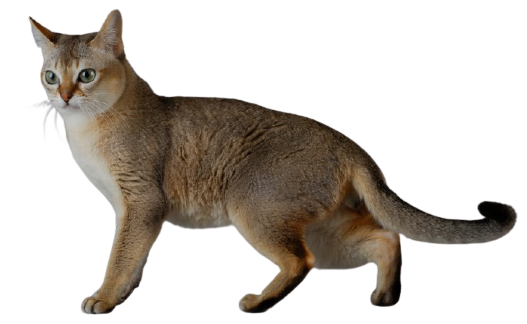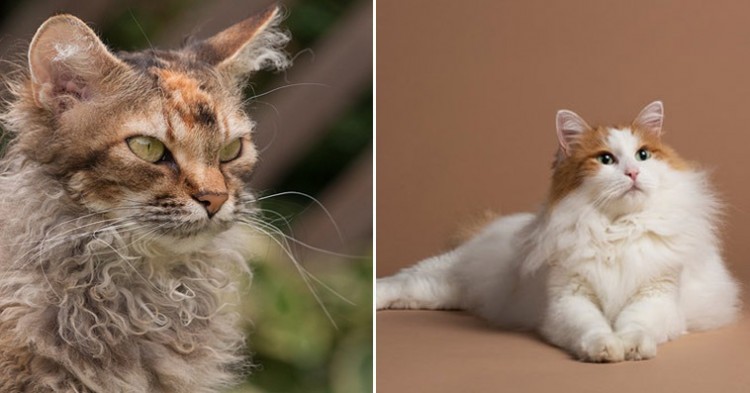
Singapura
USD $1200 - $1600 Price Avg.
Smallest, Small
Size
Yes
Lap Cat
12 to 15 years
Lifespan
Breed Information
| Popularity/Rank | 30 |
|---|---|
| Name | Singapura |
| Other names | Drain Cat, Kucinta |
| Origin | Singapore |
| Size | Smallest, Small |
| Coat | Silky, Thin, Short Hair |
| Lap Cat | Yes |
| Lifespan | 12 to 15 years |
| Temperament |
Curious, Easy Going, Intelligent, Interactive, Lively, Loyal, Affectionate 1. Curious The Singapura cat is a very curious breed. They are always exploring their surroundings and are very inquisitive. This makes them great companions as they are always interested in what you are doing. They are also very intelligent and can be easily trained to do tricks or behaviors. 2. Easy Going Singapura cats are generally easy going and relaxed. They do not require a lot of attention or care and are content to just lounge around the house. This makes them ideal for busy families or individuals who do not have a lot of time to dedicate to a pet. However, they still enjoy playing and interacting with their humans when given the chance. 3. Intelligent As mentioned before, Singapura cats are very intelligent creatures. They can easily learn tricks and behaviors with proper training. They also have a good memory, so they will remember anything you teach them for a long time. This intelligence makes them great pets for those who want an interactive companion that can keep up with their intellectually stimulating conversations. 4. Interactive Despite their easygoing nature, Singapura cats still enjoy interacting with their humans when given the chance. They love to play games and can be very affectionate when they feel comfortable around you. This makes them ideal pets for families or individuals who want a cat that will be an active part of their lives rather than just being a background presence. 5 . Lively Singapura cats are known for being lively and playful creatures. They love to run and jump around, so they need plenty of space to roam in order to stay happy and healthy. This high energy level means that they make great pets for active families or individuals who have the time and patience to keep up with their antics |
| Weight | Female: 4 - 6 pounds, Male: 6 - 8 pounds |
| Colors | Brown |
| Kitten Prices |
USD $1200 - $1600
When looking for a Singapura kitten, you can expect to pay anywhere from $1200 to $1600. The price of a Singapura kitten depends on the breeder, as well as the reputation of the breeder. Some breeders may charge more for their kittens, but this does not necessarily mean that they are of better quality. It is important to do your research when choosing a breeder, and to make sure that you are getting a healthy kitten. The price of a Singapura kitten can also be affected by the parents of the kitten. If the parents are from show lines or have championship titles, they may be more expensive. However, even if the parents are not from show lines, they can still produce healthy and beautiful kittens. It is important to remember that no two kittens are exactly alike, so even if you pay more for a kitten, there is no guarantee that it will be any better than one that costs less. When it comes to choosing a Singapura cat, there is no right or wrong answer. It ultimately comes down to personal preference and what you are looking for in a cat. If you want a cat with an outgoing personality and striking good looks, then a Singapura may be the right choice for you. However, if you are looking for a laid-back lap cat, there are many other breeds that would be better suited for your needs. No matter what type of cat you are looking for, there is sure to be one out there that is perfect for you and your family! |
Breed Characteristics
| Adaptability | |
|---|---|
| Affection Level | |
| Child Friendly | |
| Dog Friendly | |
| Energy Level | |
| Grooming | |
| Health Issues |
Feline infectious peritonitis, Feline leukemia, Feline immunodeficiency virus, Rabies, Ringworm Is Singapura cat Hypoallergenic? There is no definitive answer to this question as each individual cat has different levels of allergens. However, Singapura cats are generally considered to be hypoallergenic as they produce less of the protein Fel d 1, which is the main allergen found in cat saliva. Feline infectious peritonitis (FIP) is a viral disease that affects cats. The virus is a member of the coronavirus family, which includes the common cold virus in humans. The virus is spread through contact with infected bodily fluids, such as saliva, mucus, or blood. It can also be spread through contact with contaminated surfaces, such as food bowls or litter boxes. FIP is a serious disease that is often fatal. Symptoms include fever, weight loss, appetite loss, lethargy, and fluid buildup in the abdomen. There is no cure for FIP, and treatment is typically supportive in nature. Feline leukemia is a viral disease that affects cats. The virus is spread through contact with infected bodily fluids, such as saliva, mucus, or blood. It can also be spread through contact with contaminated surfaces, such as food bowls or litter boxes. Feline leukemia is a serious disease that can be fatal. Symptoms include fever, weight loss, appetite loss, lethargy, and fluid buildup in the abdomen. There is no cure for feline leukemia, and treatment is typically supportive in nature. Feline immunodeficiency virus (FIV) is a viral disease that affects cats. The virus is spread through contact with infected bodily fluids, such as saliva, mucus, or blood. It can also be spread through contact with contaminated surfaces, such as food bowls or litter boxes. FIV is a serious disease that can be fatal. Symptoms include fever, weight loss, appetite loss, lethargy, and fluid buildup in the abdomen. There is no cure for FIV, and treatment is typically supportive in nature. Rabies is a viral disease that affects mammals, including cats. The virus is spread through contact with infected bodily fluids, such as saliva, mucus, or blood. It can also be spread through contact with contaminated surfaces, such as food bowls or litter boxes. Rabies is a serious disease that is often fatal. Symptoms include fever, weight loss, appetite loss, lethargy, and fluid buildup in the abdomen. There is no cure for rabies, and treatment is typically supportive in nature. Ringworm is a fungal infection that affects the skin. It is spread through contact with infected animals or contaminated surfaces. Ringworm is not a serious disease, but it can be uncomfortable for affected cats. Symptoms include itching, hair loss, and scaly skin. Treatment typically involves antifungal medications. |
| Intelligence | |
| Shedding | |
| Social Needs | |
| Stranger Friendly | |
| Vocalization | |
| Health Care |
The Singapura is a relatively healthy breed of cat, but like all cats, they are susceptible to certain health problems. Some of the health problems that have been reported in Singapuras include heart disease, kidney disease, and respiratory problems.
The best way to keep your Singapura healthy is to take them to the vet for regular checkups and to keep them up to date on their vaccinations. It is also important to feed them a high-quality diet and to keep them well-hydrated. |
History
The Singapura cat is a breed of domestic cat that originated in Singapore. The breed is also known as the Singapore Shorthair. The Singapura is one of the smallest breeds of domestic cat, with adults typically weighing between 3 and 4 kg (6.6 and 8.8 lb). It is a muscular, short-haired cat with large eyes and ears, and a brown ticked coat. The Singapura is recognized by most major cat registries, including the Cat Fanciers' Association (CFA), The International Cat Association (TICA), and the World Cat Federation (WCF).
The Singapura was developed from street cats in Singapore during the 1970s. Three cats – a male named Teddy and two females named Pussey and Tickle – are considered to be the foundation cats of the breed. In 1978, American expatriate Tom Woodell brought two of these cats – a male named Sammy and a female named Missy – back to his home in Pennsylvania, where he began breeding them. In 1981, Woodell's daughter Nicoletta shipped two more Singapuras – a male named Chiko and a female named Puteh – to California, where she founded her own cattery, called Pulau Manuk after an island off the coast of Singapore.
The Singapura was first recognized as a distinct breed by TICA in 1979, followed by CFA in 1982. It was not recognized by the WCF until 2007. The CFA withdrew its recognition of the breed in 1988 after concerns were raised about outcrossing with other breeds; however, it reinstated recognition in 1991 after DNA testing confirmed that the Singapura was indeed an indigenous Singaporean breed.
The Singapura nearly became extinct during the 1990s due to outcrossing with other breeds; however, concerted efforts by dedicated breeders have helped to increase its numbers over the past few years. Today, it is still considered to be one of the rarest breeds of domestic cat; however, its popularity is slowly but steadily increasing both in Singapore and abroad.
Description
The Singapura cat is a small, brown-ticked tabby. The coat is short and fine, and the color is uniform throughout. The head is small and round, with large ears that are set wide apart. The eyes are large and round, and the tail is short and blunt.
The lifespan of the Singapura cat is 12-15 years. The size is small to medium, with a weight of 6-8 pounds. The colors are brown ticked tabby, blue ticked tabby, or lilac ticked tabby.
The personality of the Singapura cat is active, playful, and curious. They are also very affectionate with their family and love to be around people. They get along well with other cats, dogs, children, and other animals.
The temperaments of the Singapura cat are gentle, loving, playful, curious, active, and socialable. They are also very adaptable to change and can live in a variety of environments.
The health of the Singapura cat is generally good. However, they are prone to certain health conditions such as allergies, respiratory problems, heart disease, kidney disease, cancer, and diabetes. It is important to take them to the vet for regular checkups and to keep them up to date on their vaccinations.
The adaptability level of the Singapura cat is high. They can easily adjust to new environments and situations. They are also good at dealing with stress and changes in their routine. The benefits of having a Singapura cat as a pet include their affectionate nature, playfulness, curiosity ,and ability to get along with other pets and children .




